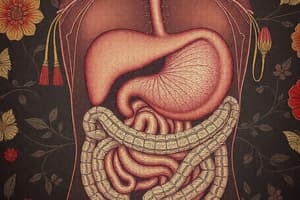Podcast
Questions and Answers
Which process occurs last in the sequence of animal nutrition?
Which process occurs last in the sequence of animal nutrition?
- Digestion
- Absorption
- Egestion (correct)
- Assimilation
What is the primary role of bile in the digestive process?
What is the primary role of bile in the digestive process?
- To emulsify fats (correct)
- To digest carbohydrates
- To neutralize stomach acid
- To absorb vitamins
Which nutrient is primarily absorbed in the small intestine?
Which nutrient is primarily absorbed in the small intestine?
- Cellulose
- Fatty acids
- Cholesterol
- Amino acids (correct)
How does digestion differ among ruminant species compared to non-ruminants?
How does digestion differ among ruminant species compared to non-ruminants?
Which vitamin is primarily absorbed in the jejunum of the small intestine?
Which vitamin is primarily absorbed in the jejunum of the small intestine?
What is the role of bacteria in the digestive process of ruminants?
What is the role of bacteria in the digestive process of ruminants?
Which of the following best explains why humans cannot digest cellulose?
Which of the following best explains why humans cannot digest cellulose?
How does the feeding mechanism of Amoeba differ from that of ruminants?
How does the feeding mechanism of Amoeba differ from that of ruminants?
What aspect of digestion is primarily enhanced by the presence of bile?
What aspect of digestion is primarily enhanced by the presence of bile?
Which of the following correctly distinguishes the digestive systems of cattle and humans?
Which of the following correctly distinguishes the digestive systems of cattle and humans?
Flashcards are hidden until you start studying
Study Notes
Animal Nutrition
- Involves nutrient requirements, food intake, and utilization in the body.
- Complex process includes ingestion, digestion, absorption, assimilation, and egestion.
Human Digestive System
- Comprised of the alimentary canal and secretory glands.
- Main components include:
- Buccal cavity
- Oesophagus
- Stomach
- Small intestine
- Large intestine (ends at the rectum)
- Anus
Digestive Glands
- Salivary glands, liver, and pancreas secrete digestive juices.
- Stomach wall and small intestine also produce digestive juices.
Digestion Process
- Carbohydrate digestion (e.g., starch) begins in the buccal cavity.
- Protein digestion starts in the stomach.
- Bile from the liver, pancreatic juice, and intestinal juice complete digestion in the small intestine.
- Digested food absorbed by blood vessels in the small intestine.
Nutrient Absorption
- Water and some salts are absorbed from undigested food in the large intestine.
- Undigested and unabsorbed residues are expelled as feces through the anus.
Ruminant Animals
- Grazing animals like cows, buffaloes, and deer are known as ruminants.
- Food is initially ingested and stored in the rumen for fermentation.
- The cud (partially digested food) is returned to the mouth for additional chewing, a process known as rumination.
Amoeba Nutrition
- A unicellular organism that ingests food using pseudopodia.
- Digestion occurs in food vacuole.
Unique Adaptations in Digestion
- Animals like horses and rabbits possess a large caecum for cellulose digestion through bacteria.
- Humans lack the ability to digest cellulose.
Key Terms
- Buccal cavity: Mouth, where digestion begins.
- Rumen: Stomach chamber in ruminants for fermentation.
- Pseudopodia: Extensions used by Amoeba to engulf food.
- Villi: Finger-like projections in the small intestine that aid in nutrient absorption.
Studying That Suits You
Use AI to generate personalized quizzes and flashcards to suit your learning preferences.




